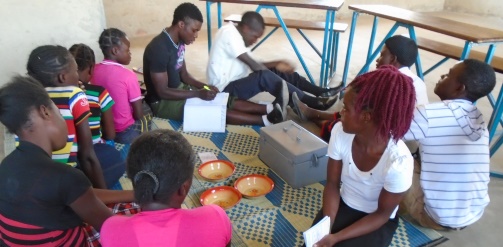Savings groups are promoted as an ideal way to promote financial inclusion in Africa, particularly among young people. Having grown in popularity in recent years, they are projected to reach up to 30 million people by 2018 (pdf), compared to only 1.5 million people in 2009 (pdf).
While programmes and models differ, in general 15 to 30 people come (or are brought) together to form a savings group (also called a village savings and loans association or VSLA). Members may receive some training, e.g. in financial literacy, entrepreneurship or employability skills, but the main point of the groups, and particularly those focused on young people, is to promote a culture of savings and responsible use of credit. The central proposition is that access to financial services will support new income generating activities and job creation.
Our newly published article (available open-access) challenges some of the assumptions that underpin efforts to promote youth savings groups. We worked with the Banking on Change (BoC) programme which operated in seven countries – Egypt, Ghana, India, Kenya, Tanzania, Uganda and Zambia – and reached over 250,000 young people.
Like many other savings group programmes, BoC conceived of the young group members as autonomous individuals, who make independent decisions about savings, credit, investment and expenditure. This conception is manifest in the way that training is targeted at individual members, and impact is seen as the effect of group membership (or training activities) on individual members’ knowledge, savings behaviour and economic activity.
A family affair
In contrast, our research highlighted the fact that engagement with youth savings groups is influenced to a large extent by family and social relations – it’s a family affair. Many of the young people we studied used the funds of other individuals (e.g. parent, spouse, boyfriend, ex-partner or other family members) or funds from other sources (e.g. existing savings or informal loans), to save and to repay loans.
For example, nearly two-thirds of women with partners saved with money they received from their partners (or ex-partners), and others reported borrowing from relatives or neighbours in order to save. Students were the most reliant on their families to save; more than four-fifths of them used money given to them by their parents to save. Savings group members also commonly handed over share-outs and/or loans to parents, guardians or others, and this was especially the case for students, who reported that one-third of the loans they took were handed over to someone else to use (versus an average of 15 percent for all interviewed members).
What are the implications?
At one level, there should be nothing surprising in the fact that a key resource, cash, flows readily along family lines. What could be less worthy of note than a husband helping a wife to save, or a student returning part of her share-out to her parents or fronting a small loan for a sibling? At another level, however, the fact that youth savings is clearly, and perhaps primarily, a family affair, means it is not viable to assume that there will necessarily be a direct relationship between training or changes in savings and borrowing behaviour on the one hand, and members’ income generation on the other.
One important implication is that this complicates how impact is conceived and measured. While training may improve a person’s ability to manage money, our research shows that many youth savings groups members’ saving and borrowing patterns are ultimately shaped to a large extent, if not mainly, by family and friends’ contributions and demands on their financial flows. Individuals’ saving rates may increase because of a family member’s increased willingness to contribute financially rather than an individual’s improved level of financial literacy.
Conversely, individuals’ income generating activities may stagnate as savings and loans are used to service a parent’s enterprise, or to pay for siblings’ school fees. Impact evaluation will therefore need to be informed by this sociological (and primarily family-based) understanding of youth savings. Programme design and implementation will also likely have to be rethought with this understanding in mind.
—
Photo credit: Justin Flynn – Young people in Zambia participating in a youth savings group meeting (where they deposit savings in the lock box and issue loans – all these transactions are recorded, is what the group secretary is doing in the picture).


